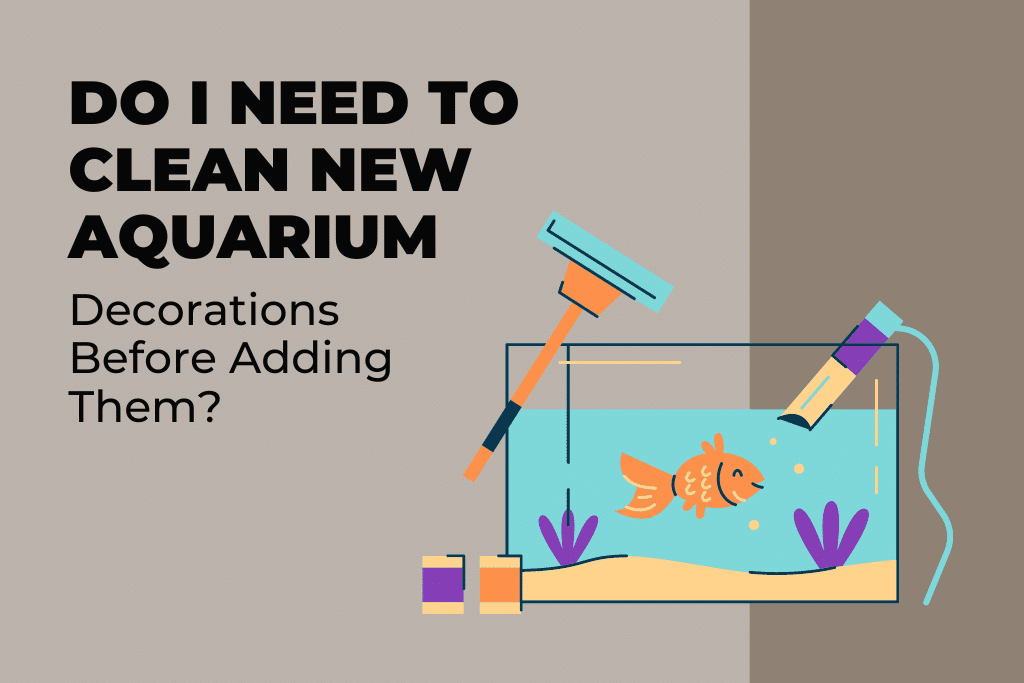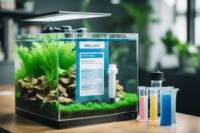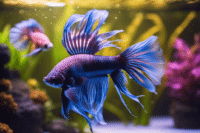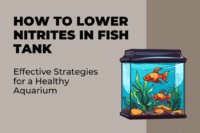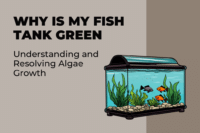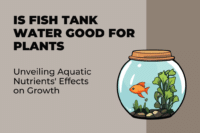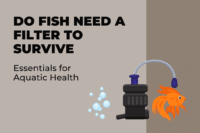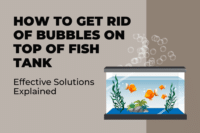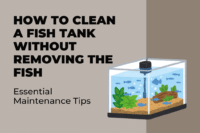Before placing new decorations into an aquarium environment, one may wonder about their need to be cleaned first. Cleaning them thoroughly ensures any new addition does not contain contaminants which could harm aquatic life in your tank – including dust particles and residue from production processes, chemicals that might alter water quality or any harmful elements like chemicals released by fish and plants themselves. Cleaning is an easy yet necessary way of maintaining balance within aquatic ecosystems.
Aquarium decorations come in different materials; understanding these can help you identify the appropriate cleaning method. Beyond aesthetic appeal, each material may harbor bacteria differently or react uniquely with cleaning agents; furthermore, regular maintenance of decorations is crucial in creating an aquatic ecosystem in which inhabitants remain healthy and thrive.
Key Takeaways
- Cleaning new aquarium decorations regularly is necessary in order to remove dust, residues and harmful chemicals that accumulate over time.
- Being aware of what material your decorations are constructed out of helps in selecting suitable cleaning methods and maintaining a healthy aquatic ecosystem.
Understanding Aquarium Decoration Materials
Materials used for aquarium decorations must not only look appealing but also ensure its safety and cleanliness – different materials could alter water quality and impact upon fish health and wellbeing.
Selecting Appropriate Decorations
Aquarium decorations not only enhance the appearance of the tank but can also provide hiding places for fish and other creatures. When selecting decorations, it is crucial to choose items that are specifically designed for aquarium use. Non-toxic and durable materials are best, as they will not degrade or leach harmful substances into the water. For instance, decorations made from food-grade plastic are safe for both freshwater and marine environments.
Common Safe Materials:
- Plastic: Widely used for its versatility and safety in fish tank decorations.
- Silicone: Often utilized in soft, flexible decorations and is harmless to aquatic life.
- Ceramic: Known for its inert properties, making it a safe choice for aquarium decor.
It is also important to consider the species of fish and plants in the aquarium, as some may have specific requirements. For instance, decorations with sharp edges should be avoided in tanks with betta fish who have delicate fins.
Materials to Avoid
Certain materials can be hazardous in an aquarium and should be avoided to ensure the health and safety of the aquatic life. Metals can corrode and release toxic substances, and decorations with paints or coatings that are not aquarium-safe can flake or dissolve, leading to water contamination.
Unsafe Materials:
- Metals: Can oxidize and release harmful ions into the water.
- Painted Decor: If not labeled as aquarium-safe, the paint may chip and contaminate the tank.
- Wood: Unless pre-treated, some woods can decay and affect water chemistry.
In summary, when selecting aquarium decorations, always opt for safe, non-toxic materials while steering clear of potentially harmful substances. This consideration ensures the sustained health of the fish and the overall ecosystem within the tank.
Importance of Clean Aquarium Decorations
Keeping aquarium decorations clean is critical for maintaining a stable aquatic environment. It prevents detrimental effects on water quality, inhibits algae growth, and ensures the health and safety of the fish.
Impact on Water Quality
Clean aquarium decorations are essential in maintaining the clarity and balance of water chemistry. Contaminants clinging to new decoration surfaces can leach into the tank, disrupting the water quality. These impurities can alter pH levels, increase nitrate concentrations, and introduce unwanted substances into the habitat.
Preventing Algae Growth
Regular cleaning of decorations significantly reduces algae buildup. Algae can quickly cover surfaces, leading to a less aesthetically pleasing tank and competing with aquatic plants for nutrients. By keeping decorations free of algae, it helps in maintaining a balanced ecosystem where plants can thrive without undue competition.
Fish Health and Safety
The well-being of the fish is paramount, and clean aquarium decorations play a role in this. Any residue or bacteria present on the decorations can be harmful to the fish, potentially causing stress or disease. Ensuring that the decorations are clean before introduction and continued maintenance thereafter safeguards against these risks, contributing to overall fish health.
Cleaning Techniques and Agents
When incorporating new decorations into an aquarium, it’s crucial to use effective cleaning techniques and agents to ensure they are safe for the aquatic environment. The following subsections explore the various methods and cleaning agents one can use, including chemicals, natural alternatives, and mechanical tools.
Using Chemicals Safely
To clean new aquarium decorations with chemicals, it’s crucial to use them responsibly to avoid harming the aquarium’s inhabitants. A bleach solution can be made by mixing no more than a 5% solution, which entails adding four teaspoons of bleach per two gallons of water. Decorations should be soaked for a short period, not exceeding fifteen minutes, and then thoroughly rinsed with water. When using bleach, one must ensure to dechlorinate the decorations completely before placing them back into the aquarium. Hydrogen peroxide is another option but should be used sparingly and always rinsed off thoroughly.
Natural Cleaning Alternatives
For aquarists preferring to avoid harsh chemicals, natural cleaning agents like vinegar provide a safe and effective alternative. Vinegar, which is acidic, helps to break down algae and mineral deposits without the toxicity risks associated with bleach. One can create a cleaning solution by mixing equal parts water and vinegar, soaking decorations for up to an hour. After soaking, scrubbing with a sponge or toothbrush can help to remove any residual dirt.
Mechanical Cleaning Tools
In addition to cleaning solutions, mechanical tools play a crucial role in the maintenance of aquarium decorations. A stiff-bristled toothbrush is ideal for scrubbing small crevices and intricate designs, where algae and dirt often accumulate. For larger surfaces, a sponge or algae pad can effectively clean without scratching the decorations. Hot water is also useful for rinsing and aiding in the removal of algae during the mechanical cleaning process. It’s important to ensure that the water is not too hot, as extreme temperatures can damage some decorations.
Step-By-Step Guide to Cleaning New Decorations
Before adding new decorations to an aquarium, it is imperative that they are safe for aquatic life and in good condition. The following step-by-step guide outlines a cleaning regimen designed to prepare new aquarium decorations.
Preparing Cleaning Solution.
Materials Needed for Water-based decorations include non-iodized salt as a natural abrasive; bleach can only be recommended when specifically recommended by a decor type; and dechlorinated or distilled water is preferable as sources.
Bucket or Container that Can Fully Submerge Decorations
Prepare a Saltwater Soak for Natural Decorations. Dissolve one cup of non-iodized salt in warm water in your bucket of choice before immersing your decorations for 10-20 minutes.
Create a 10% bleaching solution when decorating with artificial decorations by mixing one part chlorine bleach to nine parts water in an individual bucket.
Safety Tip: Always wear gloves when handling bleach and ensure the room has enough ventilation.
Soaking And Scrubbing The Process
Submerge decorations into either saltwater or bleach solution and allow to soak for 15-30 minutes (depending on which solution it’s being used for cleaning purposes). A longer soak may be required when it comes to saltwater solutions.
Caution: Never use a brush that has come into contact with household cleaners or soaps, including dish detergent.
Rinsing And Drying
Thoroughly rinse each decoration with clean, dechlorinated or distilled water to thoroughly remove all trace of cleaning solution used; this step is especially crucial if bleach was employed during its usage.
Prioritized Action: Rinsing all cleaning agents off is crucial in order to minimize harming the fish in your aquarium.
Maintain a Healthy Aquarium Environment
Assuring an aquarium environment remains healthy is integral for maintaining aquatic life’s wellbeing, and includes regular maintenance tasks, water chemistry monitoring, and effective biological filtering solutions.
Routine Aquarium Maintenance
Aquariums need regular routine maintenance in order to create an ideal ecosystem for fish and plants alike, including tasks such as cleaning the substrate, pruning plants and clearing away any debris.
Checks should be conducted regularly on equipment like the filtration system to make sure it is operating as expected, with partial water changes every month, typically changing 25-30% of your supply to rid waste substances and replenish essential minerals. As part of these tasks, water chemistry balancing should also take place to help ensure an enjoyable aquarium environment.
Water quality in an aquarium is of utmost importance; aquatic creatures depend on specific water parameters that must be strictly upheld for best performance.
Weekly assessments should include testing pH levels, hardness, ammonia levels, nitrite concentration and nitrate levels in order to maintain appropriate water parameters without shocking aquatic life. A water conditioner should also be utilized during water changes in order to remove harmful chlorine or chloramine levels that might build up due to changes. These adjustments must be implemented carefully so as not to shock aquatic creatures in any way.
Monitoring of Biological Filtration Systems
Biological filtration is an eco-friendly practice in which beneficial bacteria digest harmful contaminants found in water to provide purer quality drinking water.
These bacteria colonize surfaces within an aquarium, especially within its filter system. Maintaining its regular maintenance ensures it won’t become clogged up with debris that could inhibit bacteria’s effectiveness and therefore interfere with proper growth in an aquarium environment.
As this may drastically diminish beneficial bacteria populations, over-cleaning or replacing all filter media at once should be avoided.
